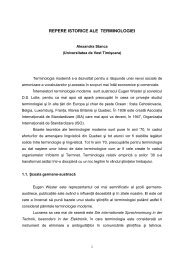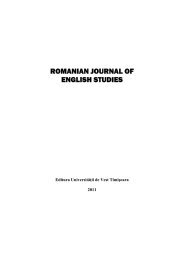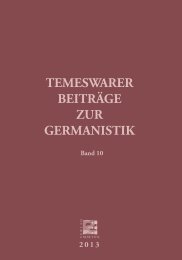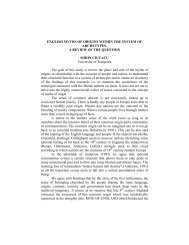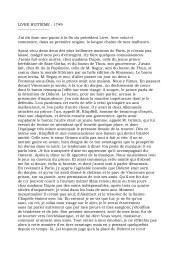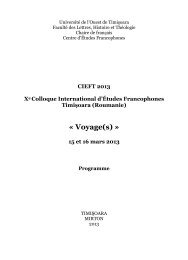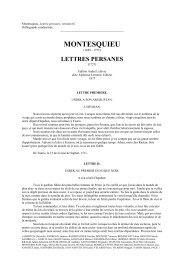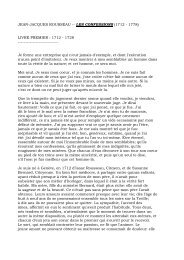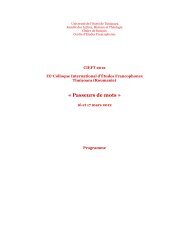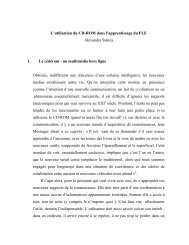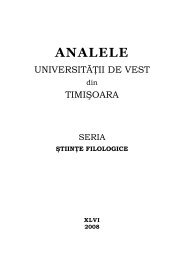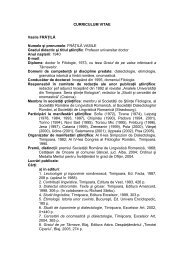TRANSLATION AND MEANING: A CULTURAL- COGNITIVE ...
TRANSLATION AND MEANING: A CULTURAL- COGNITIVE ...
TRANSLATION AND MEANING: A CULTURAL- COGNITIVE ...
You also want an ePaper? Increase the reach of your titles
YUMPU automatically turns print PDFs into web optimized ePapers that Google loves.
4. The contextual evaluation of words can be determined by<br />
linguistic and/or non-linguistic factors. The linguistic factors concern lexical<br />
and grammatical associations which determine and restrict the use of words.<br />
They include collocations and colligations. The former are lexical<br />
associations, the systematic co-occurrence patterns of a word with other<br />
words (Biber et al., 1998; Kennedy, 1991; Jones and Sinclair, 1974;<br />
Mauranen, 2000; Kenny, 2001). They are also called ready-made units,<br />
although their status as ready-made units is still unclear (Heltai, 2004:55).<br />
The latter are grammatical associations, i.e. an association of a word, “seen<br />
as a unique lexical item rather than as a member of its class,” with<br />
grammatical categories (Sinclair, 1991, 1998; Hoey, 1997), or with a<br />
particular position in a sentence or text (Hoey, 1997; Kennedy, 1991). Both<br />
structures (collocations and colligations) are of utmost importance in the<br />
analysis of word meaning (Jantunen, 2004:105). They are among the most<br />
frequent translation traps. For example, ST8: “Am durat perdele ca pe trei ierni.<br />
Am săpat bordeie. Dinspre partea banilor am împăcat pe toată lumea.” (p. 40) → TT8:<br />
“[…] the shelters I made are likely to last for three winters. And I dug mud-huts, I satisfied<br />
everybody, giving each his due.”. The verb a dura collocating with the noun<br />
perdele is used with its second meaning of a construi (Seche, Seche, Preda<br />
1993), and a făuri, a face, a clădi, a zidi, a edifica (Bulgăr, 2003). There is<br />
non-symmetry between the colligation dinspre partea banilor and the TT<br />
syntactic structure and lexical collocation giving each his due (V-ing + IO +<br />
DO).<br />
The non-linguistic factors involve register (spoken, written), dialect<br />
(social, geographic), and style specific (formal, colloquial).<br />
5. Additions are used in order to disambiguate. On analogy with<br />
Jakobsen’s (2002:241-242) model of interpreters’ additions, with written<br />
literary translations we should suggest the following types of additions: a)<br />
with no impact on the semantic and/or pragmatic content of the ST<br />
(repetitions); b) additions with minimal impact on the semantic and/or<br />
pragmatic content of the ST (repetitions), fillers, and explicating additions<br />
such as connectives and explanations used to give culture-bound<br />
information; c) with significant impact (emphasizing additions, and<br />
additions used to bring new information). For example, ST9:<br />
“Ce fel de oameni sunt pe acolo?” (p. 40) → TT9: “And the men, what kind are<br />
they in those parts?” (p. 38); ST10: “Stătea între ei o întrebare crâncenă” → TT10:<br />
“A question that burned in their hearts stood between them”; ST11: “Timpul stătu.<br />
Îl însemna totuşi cu vinerile negre în care se purta de colo-colo, fără hrană, fără<br />
apă, fără cuvânt, cu broboada cernită peste gură” (p. 43) → TT11: “ Time seemed<br />
motionless. And yet she had landmarks on those Fridays when she fasted, went<br />
without food and drink and never uttered a word, walking aimlessly, a black<br />
kerchief drawn over her mouth” (p. 40).



